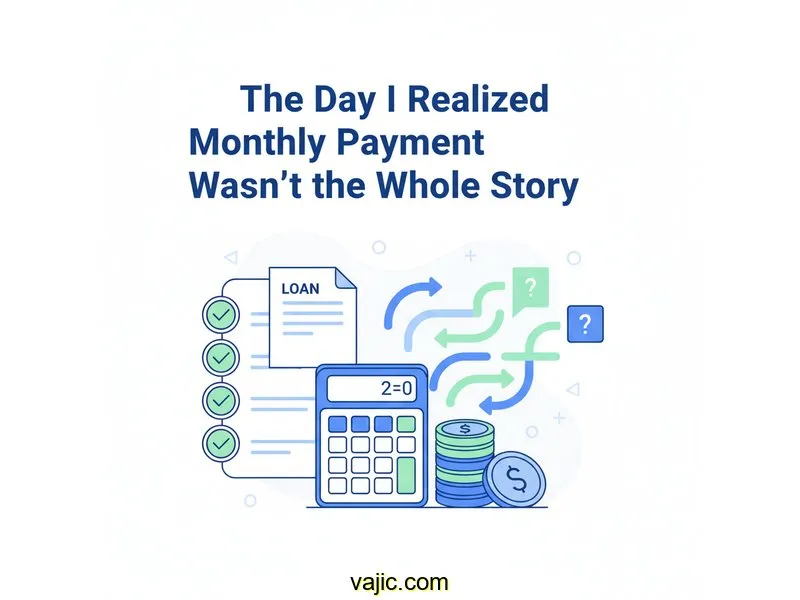
Auto Loan Calculator
Calculate payments over the life of your Loan
Home Blog Privacy Terms About Contact
Calculate payments over the life of your Loan
Home Blog Privacy Terms About ContactPublished on October 15, 2025

My journey into understanding loan math didn't start with a big financial decision. It began with a casual conversation with a friend. They mentioned they got a personal loan for a home project and were thrilled with their monthly payment. "It's so manageable," they said. Out of curiosity, I asked for the rough numbers, and when they told me, something didn't quite sit right in my head.
Their loan amount was similar to one I had been modeling in online calculators just for fun, but their monthly payment was significantly lower. At first, I just thought, "Wow, they must have gotten an amazing interest rate." But when I asked about that, the rate was actually a bit higher than the one I had been playing with. How could that be? How could a higher interest rate result in a lower monthly payment? It felt like a contradiction.
This simple puzzle sparked a deep curiosity. I realized that my entire focus had always been on that one big, bold number: the monthly payment. It was the number that represented affordability and seemed to be the most important factor. But this conversation suggested there was a hidden dimension to the calculation that I was completely missing. What was this other variable that could so drastically alter the outcome?
I decided to spend some time with online loan calculators, not to plan a purchase, but to solve this specific puzzle. My goal was simple: to understand the mechanics behind the numbers. I wanted to see how two different scenarios could produce such counterintuitive results. This article is my documentation of that learning process. It's about understanding how calculations work and how to use the tools to see the complete picture, not financial advice.
Armed with my friend's numbers, I opened up a standard loan calculator. I wanted to replicate their situation to see the math for myself. I entered the loan amount, which was $18,250, and their interest rate of 7.8%. Then I started playing with the loan term. My friend had mentioned their loan was for six years, so I entered 72 months.
The calculator instantly produced a result: a monthly payment of around $317. This matched what my friend described. I felt a small victory—I had successfully used the tool to get the right number. But the initial question still lingered. To compare, I created a second scenario. I kept the loan amount ($18,250) and the interest rate (7.8%) exactly the same, but I changed the term to 48 months (four years).
The new monthly payment was about $443. This is where my confusion peaked. My brain immediately processed this as: "$317 is much better than $443." My entire framework for comparison was based on which number was smaller and felt more manageable in a monthly budget. I was so focused on the payment that I almost missed the other data fields the calculator was showing me. Fields like "Total of Payments" and "Total Interest Paid" were just noise to me at that point.
My mistake was thinking that the monthly payment was the primary indicator of a loan's overall cost. I was equating "cheaper per month" with "cheaper overall." It's an easy mental trap to fall into, because the monthly payment is the part of the loan you interact with most frequently. But as I stared at the two results side-by-side, I realized those other, less prominent fields must hold the key to the puzzle. My singular focus on one number was preventing me from seeing the complete mathematical narrative.
The frustration of not understanding drove me to look closer. Instead of closing the browser, I decided to methodically analyze every single number the calculator provided for both the 72-month and 48-month scenarios. I wasn't just going to glance at them; I was going to write them down and compare them directly. This simple act of comparison is what led to my breakthrough.
I saw that while the 72-month loan had a lower monthly payment, its "Total of Payments" was significantly higher. For the 48-month loan, the reverse was true: a higher monthly payment, but a lower total payout. It was the first time I truly appreciated what "Total of Payments" meant. It wasn't just an abstract number; it was the actual sum of all the monthly payments I would make over the loan's life. The difference between that total and the original loan amount was the true cost of borrowing the money—the total interest.
My first big realization was that the loan term isn't just a setting; it's a powerful multiplier. Every single month you have a loan, interest is calculated on the remaining balance. So, a 72-month loan doesn't just have 24 more payments than a 48-month loan—it has 24 more instances of interest being calculated. Those extra two years of interest calculations are what drove the total cost up so dramatically.
The "Total Interest Paid" field became my new focal point. It was the answer to my original question. The reason my friend's loan would ultimately be more expensive, despite the lower monthly payment, was all contained in this one number. Seeing that the 72-month term resulted in over $1,500 in extra interest charges compared to the 48-month term was a shocking revelation. It taught me that the true cost of a loan isn't what you pay each month, but the sum of all the interest you pay over its entire life.
To deepen my understanding, I looked at the amortization schedules that most good calculators provide. I compared the very first payment for both loans. For the 48-month loan, more of that first $443 payment went toward reducing the principal. For the 72-month loan, a larger chunk of the smaller $317 payment was eaten up by interest. This showed me that with a longer loan, you make slower progress on paying down the actual debt, which means the balance stays higher for longer, allowing more interest to accumulate over time.
To verify my new understanding, I ran a third test. I kept the loan amount and rate the same but chose a 60-month (five-year) term. As I predicted, the numbers fell right in the middle: the monthly payment was around $365, and the total interest was about $3,886. This confirmed the pattern: as the term gets longer, the monthly payment drops, but the total interest paid rises. It wasn't a fluke; it was a fundamental principle of how loan math works.
This entire exercise gave me a new way to look at loan calculations. It's not about finding a single "best" number, but about understanding the relationship between all the numbers. My perspective shifted from just seeking affordability to seeking clarity. Here are the key lessons about calculation literacy that I took away from this experience:
My experience taught me to compare them on more than just the monthly payment. To get a full picture, enter the loan amount, rate, and term for each offer into the calculator. Then, place the "Total of Payments" and "Total Interest Paid" figures side-by-side. This allows you to see both the monthly cash flow impact and the total long-term cost of each option.
These are two separate variables that both significantly impact loan calculations. The interest rate is the percentage used to calculate the cost of borrowing, while the term is the duration over which that cost is spread. A calculator can help you isolate their effects. For example, you can see how a 1% rate difference compares to a 12-month term difference on the same loan amount.
Think of it like slicing a pizza. The total amount you owe (the principal plus all the interest) is the whole pizza. A longer term gives you more, smaller slices (monthly payments) to eat it. A shorter term requires fewer, larger slices. The pizza itself actually gets bigger with a longer term because more interest is added, but each individual slice is smaller because you have more time.
I learned there isn't one "most important" number, as they each tell a different part of the story. The monthly payment tells you about affordability. The total interest paid tells you the true cost of borrowing. The amortization schedule shows you the journey of paying it down. A comprehensive understanding comes from looking at how all these numbers work together.

My biggest takeaway from this journey was realizing that loan calculations are a story told by multiple numbers, not just one. My initial focus on the monthly payment was like reading only one page of a book and thinking I understood the whole plot. It was only when I took the time to explore the other fields—total payments, total interest, and the amortization schedule—that the full narrative became clear.
The simple question of how a lower payment could result from a higher interest rate led me to a much deeper understanding of the mechanics of time and interest. It showed me that a lower monthly payment isn't inherently "better"; it's simply a feature of a longer payment schedule, which has its own mathematical consequence: a higher total cost.
I hope sharing my learning process encourages others to get curious about the numbers too. Using online calculators as learning tools, rather than just as answer-finders, can demystify the math behind finance. It's about building the confidence to understand how the numbers connect and what story they are telling you.
This article is about understanding calculations and using tools. For financial decisions, always consult a qualified financial professional.
Disclaimer: This article documents my personal journey learning about loan calculations and how to use financial calculators. This is educational content about understanding math and using tools—not financial advice. Actual loan terms, rates, and costs vary based on individual circumstances, creditworthiness, and lender policies. Calculator results are estimates for educational purposes. Always verify calculations with your lender and consult a qualified financial advisor before making any financial decisions.
